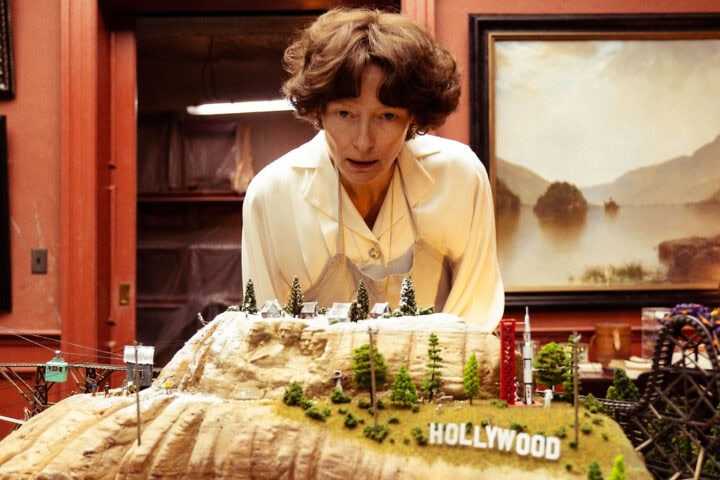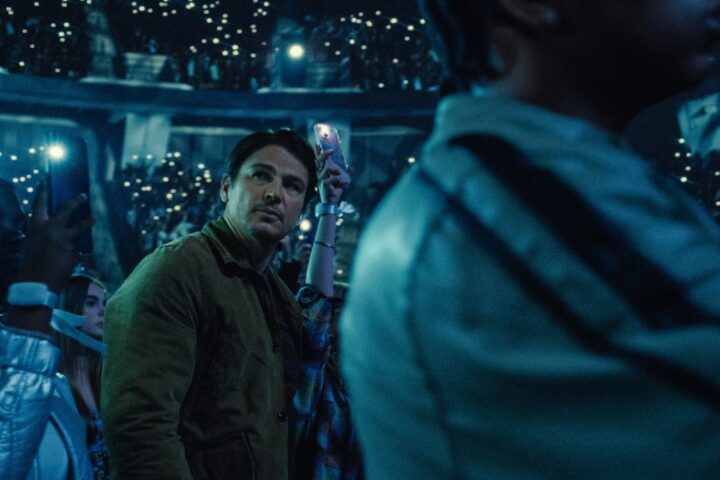“The sun shone, having no alternative, on the nothing new.” So goes the famous opening line to Samuel Beckett’s 1938 avant-garde novel Murphy. There’s nothing much new to be found in director James Marsh’s film about the legendary Irish writer either, which takes a fairly rote cradle-to-grave approach to the Nobel laureate’s life. The great shame is that there were alternatives here and, in its best moments, Dance First hints at them, flirting with a more adventurous approach that, well, might have yielded something new.
The film begins promisingly at the 1969 Nobel Prize ceremony, where Beckett (Gabriel Byrne) learns the devastating news that he’s won the prize for literature. “Catastrophe,” he grumbles to his wife, Suzanne Dumesnil (Sandrine Bonnaire), before climbing the steps up to the stage, and then up the walls of the theater itself before clambering into a strange, cave-like crevice. The surreal place he emerges into could easily have been taken from one of his plays—a strange, sparse, liminal space in which a person is prone to meeting another version of themselves.
In this moment, it seems like Dance First, written by Neil Forsyth, has struck upon an intriguing idea: telling the story of Beckett’s life in the form of a Beckett story. But what follows is decidedly less inventive. Inside the aforementioned crevice, the two Becketts begin a discussion about their biggest regrets, moving through them in chronological order as the film flashes back to show us each stage of Beckett’s life. Each section is preceded by a simple black-and-white title card naming the friend or lover Beckett feels that he wronged during that period in time, and Dance First displays a Frasier-like ability to wring wry humor from these headings.
We follow a young Beckett, played by Fionn O’Shea, as he leaves Ireland behind and travels to Paris to learn at the feet of his idol, James Joyce (an amusing but underserved Aidan Gillen). He subsequently gets drawn into a torrid would-be love affair with Joyce’s daughter, Lucia (Gráinne Good), and then into World War II, gathering intelligence for the French Resistance.
Throughout this stretch of Dance First, O’Shea delivers an assured performance that also feels like it would have been better served by a more Beckettian version of the film. His rigid body language, perennially somber expression, and the dry way in which he delivers each morosely witty line would all be quite at home in a Beckett play, but this exaggerated, caricature-like characterization of the man seems at odds with a film that wants to follow him through a very real world. And this dissonance also robs his romance with the younger Suzanne (Léonie Lojkine), who’s rendered in drably realistic terms, of any real chemistry.
Once Byrne takes over the part of Beckett, we learn more about the writer’s love life as he finds himself torn between Suzanne (now Bonnaire) and English literary critic Barbara Bray (Maxine Peak). What we don’t see is anything of Beckett’s craft. We hear others call him a “genius,” but the film displays no curiosity about the nature of that genius. It shows no real interest in his worldview, his theatrical innovations, or anything that made him the monumental literary figure that he was. Rather than grappling with the mind and soul of the man who birthed bizarre, fatalistically funny and existentially unsettling works like Waiting for Godot, Marsh’s film seems content to merely adapt the “Personal Life” section of Beckett’s Wikipedia page.
Worse, the rare moments in which the film does engage with Beckett’s work display a pretty questionable understanding of it. Godot is simplistically explained as a Holocaust analogy, which is the sort of reductive interpretation that Beckett thoroughly rejected. When he was asked what Godot “meant,” he famously replied, “If I knew, I would have said so in the play.”
The film also sees Beckett using the phrase “Dance first, think later”—an oddly uplifting soundbite that’s actually a truncated version of an exchange from Godot. Whether or not Beckett did actually offer that advice to one of his students is unclear, but it’s indicative of the film’s entire approach to its subject that it opts for this tritely straightforward version of the line.
Since 2001, we've brought you uncompromising, candid takes on the world of film, music, television, video games, theater, and more. Independently owned and operated publications like Slant have been hit hard in recent years, but we’re committed to keeping our content free and accessible—meaning no paywalls or fees.
If you like what we do, please consider subscribing to our Patreon or making a donation.



